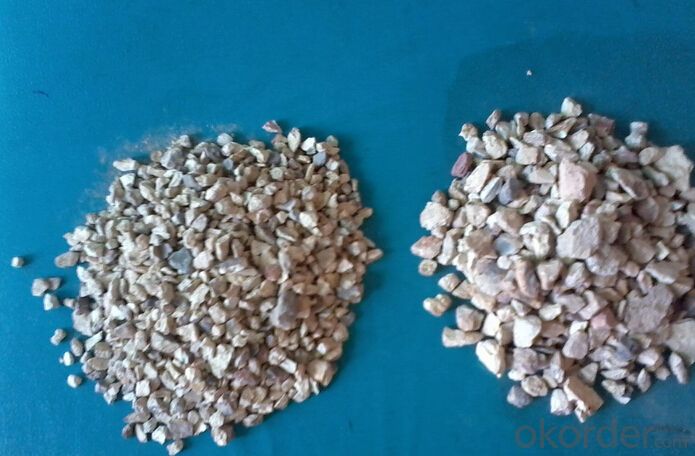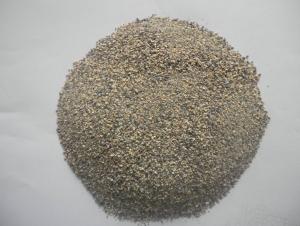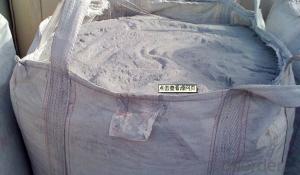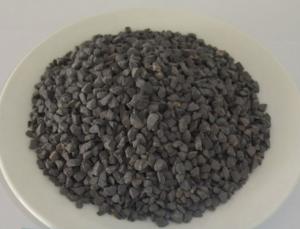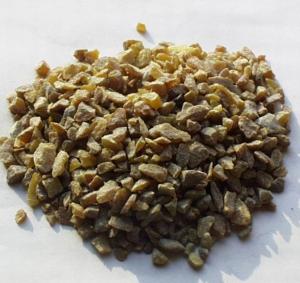Raw Materials for Refractory:High Bauxite Clinker with 1780°C Refractoriness
- Loading Port:
- Tianjin
- Payment Terms:
- TT OR LC
- Min Order Qty:
- 20000 m.t.
- Supply Capability:
- 10000000 m.t./month
OKorder Service Pledge
OKorder Financial Service
You Might Also Like
1.Structure of Calcined Bauxite Description
Bauxite (aluminous soil; Bauxite) is also called the alumina or bauxite, main ingredients are alumina, hydrated alumina containing impurities, is an earthy mineral. White or gray, brown and yellow or light red by iron.
2.Main Features of the Calcined Bauxite
Calcined bauxite is one of the principal ore of aluminum. Calcined bauxite contains hydrous aluminum oxides and aluminum
hydroxides, formed through the laterization of aluminous rocks in tropical and subtropical areas .Calcined bauxite is obtained by calcining (heating)superior grade bauxite at high temperature (from 85OC to 1600C) .This removes moisture there. By increasing the alumina content,compared to an alumina content of about 57%to 58% in raw bauxite, calcined bauxite has an alumina content of 84%to88%.The heating is carried out in rotary kilns.
3.Main usage of the Calcined Bauxite
(1) aluminium industry. Used in national defense, aerospace, automotive, electronics, chemical industry, daily necessities, etc.
(2) precision casting. Alumina clinker made after the mould precision casting processed into fine powder. Used in military industry, aerospace, communications, instrumentation, machinery and medical equipment department.
(3) is used for refractory products. High bauxite clinker refractoriness is as high as 1780, chemical stability strong, and good physical properties.
4. Calcined Bauxite Images




5. Calcined Bauxite Specification
Rotary Kiln Calcined Bauxite G.G.NO.1 Specification : Al2O3 : 80.00 + % Fe2O3 : 3.8 % SIO2 : 6 To 8% Cao : 2.2 To 2.5% TIO2 : 5 To 6 % , 0-1MM OR 1-3MM
Rotary Kiln Calcined Bauxite G.G No.2 Specification : Al2O3 : 78 % Fe2O3 : 4 TO 4.2% SIO2 :
6.FAQ of Calcined Bauxite
1). Q: Are you a factory or trading company?
A: We are a factory.
2). Q: Where is your factory located? How can I visit there?
A: Our factory is located in ShanXi, HeNan, China. You are warmly welcomed to visit us!
3). Q: How can I get some samples?
A: Please connect me for samples
4). Q: Can the price be cheaper?
A: Of course, you will be offered a good discount for big amount.
- Q: Development trend of refractories
- The foundation of China's refractories industry is still relatively weak, the utilization level of refractory material resources is low, the quality of refractory materials is not high, excess production capacity of ordinary products, the key products of some high-quality high technology content can be produced, but the quality is not stable, and the service life of refractory material consumption compared with foreign advanced level, there is a considerable gap. Therefore, the new trend of tracking foreign refractories science and technology development, carry out and supporting the development and application of advanced and basic theory research, to promote technological innovation of refractory materials, optimizing product structure, industrial structure adjustment, implementation of the strategy of sustainable development, it is very necessary.
- Q: I know which material is the fire resistance rolling shutter door
- the materials of fire resistance rolling shutter door are: the inner of fire resistance rolling shutter door is generally filled with aluminum silicate fiber cotton. fire resistance rolling shutter door is divided into AAA inorganic fireproof rolling shutter door and steel fire resistance rolling shutter door. the fireproof?performance of inorganic fireproof rolling shutter door is better, but steel fire resistance rolling shutter door has a certain wind load resistance, which can be installed outdoors.
- Q: What kind of fireproof material is used for steel structure?
- Steel is a building material that does not burn, it is shock resistant and anti-bending. In practice, Steel can increase load capacity of the building, but also add asthetic beauty to the architecture design; Unlike concrete, it can bend and stretch. Therefore, the steel construction industry has been favored, such as one-story or multi-story buildings, skyscrapers, factories, warehouses, waiting rooms and waiting hall, which is the common use of steel. However, the steel as building materials has unavoidable defects in fire prevention, its mechanical properties such as yield point, tensile strength and modulus of elasticity, decrease abruptly due to temperature rise.
- Q: What's the difference between refractory metal raceway and fireproof raceway?
- Refractory metal is used to lay and control cables, while trunking is used to lay wires and communication cables; refractory metal is bigger (200*100-600*200), while trunking is smaller; refractory metal has bigger turning radius, while trunking mostly turns a right angle; refractory metal has larger span, while trunking has smaller span; their fixation and installation ways are also different.
- Q: How to apply the alumina powder on refractories?
- What kind of the refractories can make the aluminium oxide increase the aluminum content and specific gravity, and erosion-resistant.
- Q: Who knows about the differences between 3M fireproofing materials and ShiLiDe materials?
- ShiLiDe materials are rubbish which can not used in many industries now, because the main materials of which are mineral wool boards. These boards are harmful to human body, will lead to chronic poisoning, and the quality of which is bad! You must pay attention to it! They can not be used in chemical and pharmaceutical plants.
- Q: What are Grade-A waterproof inorganic thermal insulation materials?
- Grade-A waterproof inorganic thermal insulation materials include: 1. external wall thermal insulation materials: (1) silicate thermal insulation material (2) gelatine powder polyphenyl granule (3) steel wire gauze picking cement cystosepiment (Estazolam plate) (4) extruded sheet; 2. roofing materials: (1) XPS Extruded sheet (2) EPS cystosepiment (3) perlite and perlite bricks (4) vermiculite brick; 3. heating and air conditioning material: PUR, rubberplastic sponge, polystyrene foam, glass wool, rock wool; 4. steel structure material: polystyrene, extruded board, polyurethane board, glass wool roll mat, etc.
- Q: What are the components of refractory clay?
- It is different from non-cement castable refractories, which does not rely on the addition of cement for combination, instead it uses chemical binder. It is refractory castable (also known as chemical bonding castable). Non-cement refractory castable takes oxide or synthetic compound ultra-fine powder or oxide sol-gel which is similar to the chemical composition of material in tungsten castable. Since the use of superfine powder or sol as binder, it has low impurity content, and therefore the refractoriness and slag erosion resistance of the castable will not be reduced. Besides, the self combination in use can help to improve high-temperature structural strength. Non-cement castable refractory is made up of refractory aggregate and powder, superfine powder of oxide or sol, trace amount of dispergator (or anti-coagulant) and proper slow acting hardener. Non-cement castable is mainly coagulated and combinated by ultrafine powder of oxide or sol, therefore, it has certain requirements for ultrafine and sol. Ultrafine powder used refers to less than 1 / zm particles. Ultrafine powder used in non-cement castables are SiO2, Al2O3, Cr2zrOz, etc. SiO micro powder is often adopted, which is the dust recycled during the smelting of metallic silicon, ferro-silicon alloy, the generation process is as follows: This recycled SiO2 powder has an average particle diameter of 0.5 pM, and it is spherical with large surface area. It is amorphous substance with high activity, so it has good bonding strength. The sol used are mainly alumina oxide and silica sol. Silica sol is made by ion exchange of sodium silicate after Na ions are removed. It can also be made after hydrolysis of ethyl silicate. There are several ways of preparing alumina sol, the easiest method is to prepare by the reaction of metallic aluminum or alchlor with hydrochloric acid.
- Q: How do refractory materials apply into pyrophyllite?
- Generally speaking, shaped refractory materials require of some powdery materials like spray grouts and iron trough in addition to pyrophyllite brick made of a mixture of pyrophyllite aggregate and powers.
- Q: What is glass furnace used high-grade refractory materials?
- It is said that building a furnace need 30 million? After the ignition, it can't be gone out. Only at the waste to maintenance?
Send your message to us
Raw Materials for Refractory:High Bauxite Clinker with 1780°C Refractoriness
- Loading Port:
- Tianjin
- Payment Terms:
- TT OR LC
- Min Order Qty:
- 20000 m.t.
- Supply Capability:
- 10000000 m.t./month
OKorder Service Pledge
OKorder Financial Service
Similar products
Hot products
Hot Searches
Related keywords



